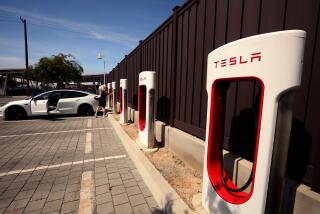At 1,600 MPG, Don’t Expect Much Headroom
- Share via
When Gina Parodi was a senior at South High School in Torrance, male classmates in auto shop would not let her take apart the lawn mower motor they were studying.
But Parodi, who grew up building miniature roller coasters for pinballs and radio-controlled dune buggies, finally got her hands on a lawn mower motor three years ago.
She joined a club at Cal State L.A. that designed a car each year for the international Supermileage competition sponsored by the Society of Automotive Engineers. The goal of the 25-year-old challenge for engineering students is to build the most fuel-efficient car around a lawn mower motor.
“I was like a little girl at Christmas,” said Parodi, now 27.
About 200 students from 33 schools across the country participated in the contest.
This year, the car built by Parodi and 15 student teammates beat all entries but one. Cal State’s Super Eagle, named after the college mascot, achieved 1,615 miles per gallon while driving a 9.6-mile course in Marshall, Mich.
Only a Batmobile look-alike from the University of British Columbia, in Canada, which weighed less than the Super Eagle, bested the L.A. team with 1,747 mpg. The difference in fuel use: 2.12 grams.
Built in a garage on campus, Cal State’s 110-pound car looks like an egg that tapers in the back to a fin. A tinted polycarbonate windshield and a carbon fiber and Kevlar composite shell cover an aluminum frame. The 2-horsepower motor still makes the putt-putt noises of a lawn mower, but it can, with a specially designed electronic fuel injection system, thrust the car up to 63 miles per hour.
The tiny three-wheel car holds one person, who leans back in a hammock in the “neutral body position” that astronauts use when taking off in space shuttles. The road is visible through the car’s windshield and interior mirrors. Steering and braking are controlled by what looks like a bicycle handlebar rising from the floor.
Not surprisingly, the Super Eagle lacks some typical car items -- reverse gear, for one.
Cal State L.A. has entered the last four competitions and steadily climbed the rankings. Last year, the team placed sixth, behind perennial heavyweights UC Berkeley and the University of British Columbia.
“They realized they could have been in first place if they did a little more,” said James Ettaro, an associate professor of technology and the team’s advisor. “They decided they wanted to win this year.”
Each entry must differ significantly from the previous year’s, so the team got right to work, culling new ideas from the Internet, books and trade magazines.
While writing grant proposals to pay for the $15,000 worth of materials on the car and their travel expenses to Michigan, they designed prototypes on a computer, then ordered raw materials such as fuel lines and carbon fiber from do-it-yourself aircraft catalogs. They cut other parts from blocks of aluminum in the lab’s machine room.
Some things, they didn’t make from scratch. For good luck, they cribbed the rear wheel from the Solar Eagle, which won the university first place in a 1997 contest for solar-powered cars.
The students tinkered with nearly every aspect of the car, including quickening the microprocessor that controls fuel injection, changing the lengths of connecting rods and reshaping the combustion chamber. But they won’t reveal specifics.
“The shape is key, besides the cam,” Parodi said.
“But if we say the shape, then everybody gets in on the idea,” added Akilesh Vedartham, a mechanical engineering student who worked extensively on the engine.
The students also devised a driving strategy that conserved the most fuel while obeying contest rules. First they found an experienced driver below the minimum weight of 130 pounds (121-pound student De San) and packed in bottles of lead shot to make up difference. Then they directed San to accelerate to 30 mph and coast until the car slowed to 15 mph, the minimum speed requirement.
For all this planning and testing, team members each spent about 20 hours a week at the lab, neglecting much of their social lives.
“Supermileage dominates your life,” said Jeff Kay, 24. “I’ve missed anniversaries with girlfriends.”
But the benefits of working on Super Eagle can be immediate.
“You can apply it all to your own car,” Kay said. To allow his engine to work more efficiently at higher speeds, he fitted a longer intake pipe and fatter exhaust pipe on his Mitsubishi Lancer. Kay also lowered the suspension so the car can corner better and tinted the windows to reduce glare. He plans to paint flames on his car like the ones the team put on Super Eagle.
Car design contests also can lead to jobs. Makers of cars and transmissions have approached winners at the competition. Some employers consider the project one year of experience.
Steve Mazor, the principal automotive engineer with the Automobile Club of Southern California, said he got his first job after winning some 1973 contests as a UCLA student with an AMC Gremlin modified to run on hydrogen.
The professional community often gets stuck thinking, “We always do it this way,” said Mazor, who belongs to the Society of Automotive Engineers. “Students haven’t developed those patterns yet. So they may try half a dozen ideas that don’t work. But then they’ll find something someone else hasn’t thought of before.”
But don’t expect a 1,600-mile-per-gallon car to hit the road any time soon. “These are only 300-pound cars that run on a track at a constant speed and a low speed,” Mazor said.
Even the smallest passenger cars weigh about a ton, and a driver has to navigate stop signs and hills.
“You can’t just drive a car 40 mph on the road,” he said. “When you accelerate and decelerate, that eats up a lot of fuel.”






